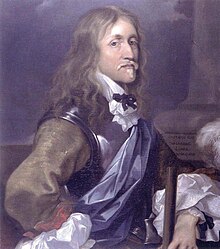Wasaburg
Wasaburg , Swedish Vasaborg , was the name of a Swedish noble family living mainly in Germany, which formed a hybrid line of the Swedish royal house Wasa .
history

The Swedish King Gustav II Adolf had an extramarital relationship with the Dutch Margarethe Cabeliau. In 1616 their son Gustav Gustavson (1616–1653) was born from it. He started his career as an officer, occupied the bishopric of Osnabrück in the Thirty Years' War in 1633 and became administrator of the prince-bishopric until 1650. In 1637 he was raised to the nobility as Baron von Wasaburg ( af Vasaborg ). Queen Christina made her half-brother Count of Nystad in 1647 . At the same time, the family was accepted into the count's class of the knight's house under number 6 .
Gustav Gustavson was married to Anna Sofia von Wied-Runkel (1616–1694), the sister of Count Friedrich III. from Wied. After the Peace of Westphalia he received a severance payment and Wildeshausen became the seat of the family.
Of the couple's children, Gustav Adolf (1653–1732) also became an officer. He was married to Angelika Catharina von Leiningen-Westerburg . In 1675, the Prince-Bishop of Münster, Christoph Bernhard von Galen , captured Wildeshausen and destroyed Huntlosen Castle, which was built by Gustav Gustavsson . After the Peace of Nijmegen in 1679, Gustav Adolf von Wasaburg pledged the Wildeshausen reign for 100,000 Reichstaler to the Prince-Bishop of Münster Ferdinand von Fürstenberg . In 1721 the Wildeshausen office became part of Kurhannover . Due to these circumstances, Gustav Adolf stayed more with his wife's family in Westerburg and Grünstadt . His brother Anton Adolf von Wasaburg (1689–1748) was Swedish major general in the Great Northern War .
In the male line, the gender died out in 1754 with the death of Georg Moritz von Wasaburg (1678–1754), the son of Gustav Adolf. He was also the last male descendant of the Wasa family. His sister Countess Henrietta Polyxena (1696–1777) was the last bearer of the name. She died in Huntlosen and is buried there too.
coat of arms
The Vasaborg family coat of arms showed the golden wasagarbe crossed by a diagonal red bastard thread on a silver shield .
The Count's coat of arms is squared with a heart shield , in it the family coat of arms; 1 and 4 in blue an inward-facing, crowned, silver griffin; 2 and 3 in gold two turned upright fish with natural scales, over which a golden crown hovers (the coat of arms of Nystad).
Stralenheim-Wasaburg
See also: Stralenheim (noble family)
The sister of the last Count Wasaburg, Sophia Elisabeth Christina von Wasaburg (1694–1756) married Count Henning von Stralenheim , the Swedish governor of Zweibrücken , in 1716 . From this marriage there were two children: Catharina Sophia (1717–64), who married the French baron Eric Sparre (1700–1742), and Henning Gustav (1719–1787).
Henning Gustav von Stralenheim began to use both names and now called himself Graf von Stralenheim-Wasaburg . He married Freiin Caroline von Esebeck ; their children together continued the count's line until it died out in the male line in 1872.
After initially tolerating, King Gustav III prohibited his distant cousin Henning Gustav the use of the Swedish title and the name Wasaburg , which could not be enforced.
The alliance coat of arms Stralenheim-Wasaburg on the epitaph Hennings von Stralenheim in the collegiate church St. Arnual showed a silver bundle of rays in black on the wife's side in the Wasaburg family coat of arms . Currently, the two coats of arms of the husband and wife are no longer tinged, but instead have a uniform golden color.
The Count's coat of arms Stralenheim Wasaburg combines the two main coats of arms Stralenheim and Wasaburg split in the main coat of arms.
Monuments
- Burial chapel in Riddarholmskyrkan , Stockholm
- Epitaph for Henning von Stralenheim and Sophia Elisabeth Christina von Wasaburg in the collegiate church of St. Arnual
The Wasaburger Weg in Großenkneten -Huntlosen is named after the noble family .
literature
- Max Besler: History of the castle, the rule and the city of Forbach. Forbach: Hupfer 1895
- Oskar Brunken: The Wasaburg in the Wildeshausen office: the life of the descendants of Gustav Adolf of Sweden in the mirror of Oldenburg sources. (Oldenburger Studien 32) Holzberg 1988 ISBN 3873583208
Web links
- Literature on the Wasaburg family in the catalog of the German National Library
Individual evidence
- ↑ see Besler (Lit.), p. 60
- ↑ Information on the burial chapel ( Vasaborgska Gravkoret )

